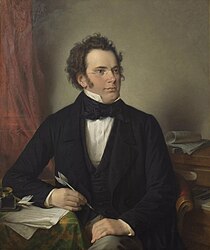 Franz Peter Schubert (German pronunciation: [ˈfʁants ˈʃuːbɛɐ̯t]; 31 January 1797 – 19 November 1828) was an Austrian composer.
Franz Peter Schubert (German pronunciation: [ˈfʁants ˈʃuːbɛɐ̯t]; 31 January 1797 – 19 November 1828) was an Austrian composer.Although he died at an early age, Schubert was tremendously prolific. He wrote some 600 Lieder, nine symphonies (including the famous "Unfinished Symphony"), liturgical music, operas, some incidental music, and a large body of chamber and solo piano music. Appreciation of his music during his lifetime was limited, but interest in Schubert's work increased dramatically in the decades following his death at the age of 31. Franz Liszt, Robert Schumann,Johannes Brahms and Felix Mendelssohn, among others, discovered and championed his works in the 19th Century. Today, Schubert is admired as one of the leading exponents of the early Romantic era in music and he remains one of the most frequently performed composers.
Numbering of symphonies
Confusion arose quite early over the numbering of Schubert's symphonies, in particular the "Great" C Major Symphony. George Grove, who rediscovered many of Schubert's symphonies, assigned the following numbering after his 1867 visit to Vienna:
- Number 7: E major D. 729 (completely sketched but not completely scored by Schubert, with multiple historic and modern completions)
- Number 8: B minor Unfinished D. 759
- Number 9: C major Great D. 944
Breitkopf & Härtel, when preparing the 1897 complete works publication, originally planned to only publish complete works (which would have given the Greatnumber 7), with "fragments", including the Unfinished and the D. 729 sketch, receiving no number at all. When Johannes Brahms became general editor of that project, he assigned the following numbers:
- Number 7: C major Great
- Number 8: B minor Unfinished
- no number: E major D. 729
Some of the disagreement continued into the 20th century. George Grove in his 1908 Dictionary of Music and Musicians, assigned the Great as number 10, and the Unfinished as number 9. (It is unclear from his article which symphonies, fragmentary or otherwise, are numbers 7 and 8.) However, the Unfinished is now generally referred to as number 8 in the English-speaking world, with the Great at number 9. Number 10 is generally acknowledged to be the D. 936a fragment, for which a completion by Brian Newbould exists. The 1978 revision to the Deutsch catalog leaves D. 729 without a number (in spite of numerous completions), and assigns number 7 to the Unfinished and number 8 to the Great. As a consequence, generally available scores for the later symphonies may be published using conflicting numbers.
Grove and Sullivan also suggested that there may have been a "lost" symphony. Immediately before Schubert's death, his friend Eduard von Bauernfeld recorded the existence of an additional symphony, dated 1828 (although this does not necessarily indicate the year of composition) named the "Letzte" or "Last" symphony. Brian Newbould[54] believes that the "Last" symphony refers to a sketch in D major (D. 936A), identified by Ernst Hilmar in 1977, and which was realised by Newbould as the Tenth Symphony. The fragment was bound with other symphony fragments (D. 615 and D. 708a) that Schubert had apparently intended to combine.

Tidak ada komentar:
Posting Komentar